Have you seen the list of noodle dishes at your local Chinese restaurant and wondered what is the difference between lo mein and chow mein? Here’s a hint. It’s actually not the type of noodles used. Let’s take a look.
Asian Noodle Dishes
Chow mein and lo mein. Could you tell the difference between them if asked?
I don’t know about you, but we find the breakdown of Asian noodle dishes to be quite confusing.
Truth is, in the States, we are mostly used to these dishes in the form of Chinese takeout, which transforms cultural cuisine into one big mess of salty and sweet, American-adapted, cultural confusion.
I mean, many restaurants will even use the terms ‘lo mein’ and ‘chow mein’ interchangeably for their general noodle dishes.
They really don’t help the cause with their naming conventions. And, really, everything from the restaurants tends to look (and taste) the same anyway, it’s so hard to pick out any marked difference.
So, let’s take a look.
What’s The Difference Between Chow Mein and Lo Mein?
Mein (or mian) is simply the Chinese word for ‘noodles‘ (pronounced ‘me-an’).
Both lo mein and chow mein are made from the same type of Chinese noodle. This noodle is made from wheat flour and eggs, similar to Italian pasta.
If you live near a good Asian grocer, you can probably find these sold as ‘lo mein noodles’ or even ‘chow mein noodles’. But if you don’t, using regular Italian spaghetti or linguine noodles is a great substitute.
So, if it’s not the noodles, then what is the difference?
What makes the two dishes different is how the noodles are prepared.
What Is Lo Mein?
Lo means ‘tossed‘. So, when we’re talking about lo mein, we’re talking, quite simply, about ‘tossed noodles‘.
To make lo mein, cooked (boiled and drained) noodles are added to the wok after the veggies and protein have been cooked and tossed with the sauce. The noodles are lightly tossed with the veggies, just until they are heated through.
Here’s how you can tell if you’re eating lo mein.
- There’s a light sauce
- The noodles aren’t greasy
- The dish includes veggies (and possibly protein) that have been tossed with the noodles and sauce
What Is Chow Mein?
Chow, on the other hand, means ‘fried‘. So, for chow mein, we are talking about ‘fried noodles‘.
There are two types of chow mein.
- Crisp chow mein – Where the noodles are pressed flat when frying, to make a sort of pancake
- Steamed chow mein – Where the noodles are fried while tossing and coated in a sauce after the initial frying
To make chow mein, after boiling, the noodles are fried in oil (without any accompaniments).
After the initial frying, sauce or accompaniments are added to the noodles.
In chow mein, the noodles really are the star of the show, so any vegetable or protein add-ins are kept to a minimum so they don’t distract from the perfectly crispy noodles.
Here’s how you can tell if you’re eating chow mein.
- The noodles are oily (steamed chow mein) or distinctly crispy (crisp chow mein)
- The amount of veggies and/or protein is at a minimum
- The sauce is thicker and dark
Eating Chinese Noodles For Good Luck
In China, noodles are one of the traditional foods that are eaten during celebrations of the Lunar New Year.
They are the perfect dish to start off the year with promise, because long noodles are a symbol of longevity in life.
So, cook those noodles long and don’t cut them!
Let’s raise our bowls to a long life of noodle slurping!
If you liked this recipe, here are some similar dishes you may enjoy!

Sarah founded Curious in 2010 as a way to save her recipe creations and share culinary experiences. Her love for cultural cuisines was instilled early by her French Canadian Grandmother. Her experience in the kitchen and in recipe development comes from over 10 years working in professional kitchens. She has traveled extensively and enjoys bringing the flavors of her travels back to create easy-to-make recipes.
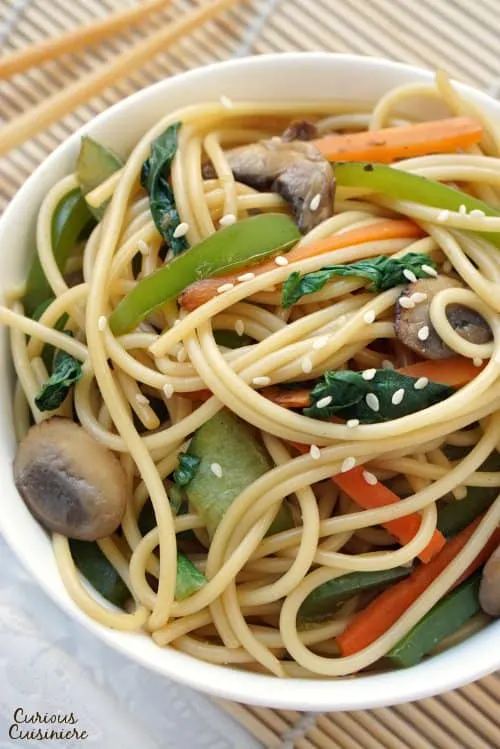
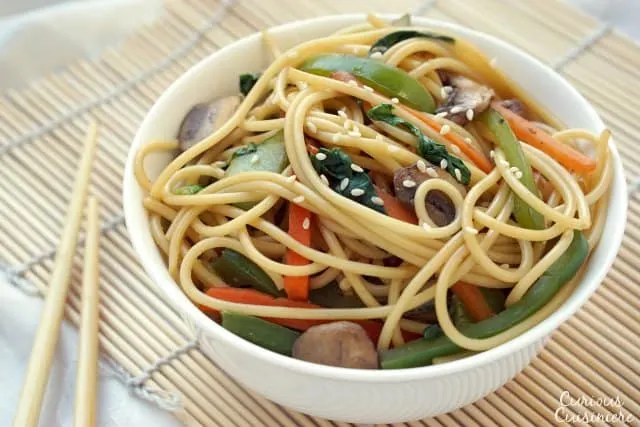
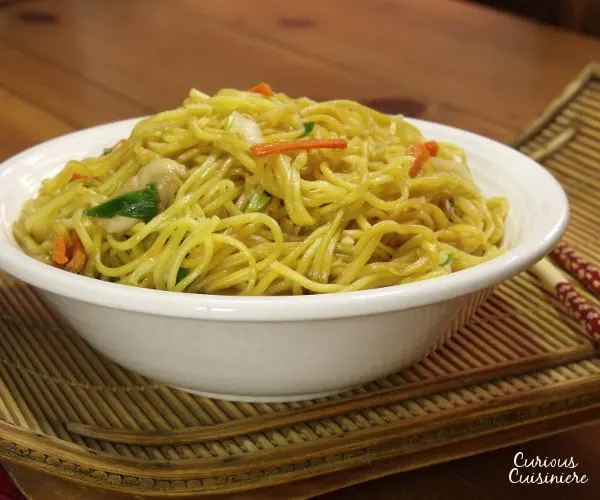
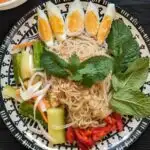

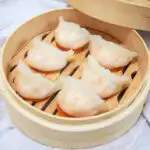


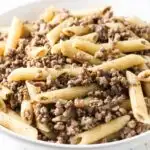

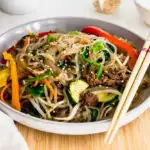
Stephanie
Monday 1st of February 2021
I had to leave a comment to make a correction. I'm sure you are a great cook, but, Americanized Chinese food isn't real Chinese food, so for people who want a Chinese recipe, best go to a recipe written by a Chinese person. When we first tried Chinese food in America, it was nothing remotely close to Chinese food, hence, (I believe) confusion about lo mian and chow mian. Firstly, the correct pinyin is "lao mian" and "Chao mian", but of course, the spelling just had to be westernized. It is correct that "mian" means noodles (technically it means wheat flour, while "mian tiao" means noodles, because"tiao" means strips) Neither "lo mian" and "chow mian" are types of noodles, the way spaghetti and penne pasta are different pasta types in Italy; Chao mian actually just literally means "stir fried noodles", while "lao mian" literally means "scooped out noodles" and isn't even a real thing in China - instead, it's should be "ban mian" high means "mixed noodles", where plain, boiled noodles are "scooped" out of the water and mixed with condiments like vege, meat and sauce. In Sydney where I live now, the Chinese restaurants just call them stirfried and mixed noodles. So, what you Americans know as 'lo mian' and 'chow mian' aren't even real Chinese food.
Also it is written and pronounced as "mian", as in the "mi" in "middle". Or you can remove ambiguity and say it is pronounced "me ann".
AnnaG
Thursday 15th of June 2023
@Stephanie, the dishes are as real as the Chinese people making them in their American restaurant. FYI, Chinese restaurants aren't owned by Americans. Chinese immigrants adapted to their menus to the availability of local produce and meats. They also adapted menus to the preferences of their target market. Stop blaming Americans for the lack of authenticity in Chinese dishes.
These adaptations happen with ethnic cuisines throughout the world! I know. I have lived in several foreign countries.
Sarah Ozimek
Tuesday 2nd of February 2021
Thanks for your insight Stephanie. Although, I must say I'm not sure what your correction is, as we actually cover a lot of what you mentioned in our article. Just because we're American doesn't by default mean we got it wrong. Thanks for affirming that we actually got it quite right!
Wendi
Monday 15th of June 2020
This is terrific post. Kind regards, Mead Duke
Sarah Ozimek
Friday 19th of June 2020
Thank you!
Bradley Bill Parker
Saturday 16th of November 2019
I have acquired the wok, I have purchased a few of the items I'd likely need or want to use. This is what I personally really like about the internet, coming across likely everything I'll need in a Chinese food recipe, and the helpful cooking instructions, Oh yah.! Thanks so much for sharing this with, us. Sincerely yours, Mr. Bradley Bill Parker ✝️⛹️? ?
Sarah Ozimek
Monday 18th of November 2019
Happy cooking! :)